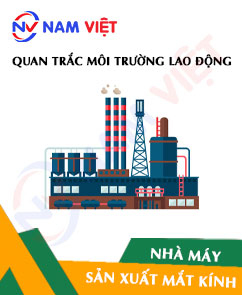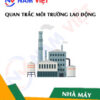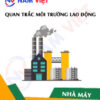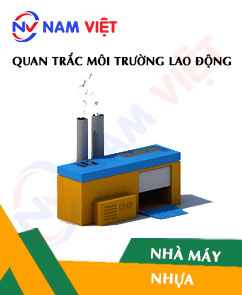Occupational environment monitoring at an eyeglass manufacturing factory
99,000 ₫
Note: The above price is calculated for one sample, and the price may fluctuate depending on the area of the environment to be monitored and market movements. For more accurate pricing support, please refer to the price list or contact our consulting staff directly.
Monitoring the environment of an eyeglass production factory is a session of collecting, analyzing, and evaluating workplace factors that may be harmful to workers’ health.
Table of Contents
Toggle1. Overview of the Eyeglass Manufacturing Factory
a. What is an Eyeglass Manufacturing Factory?
Factory manufacturing eyeglasses is a production facility specialized in producing different types of eyeglasses such as prescription glasses, contact lenses, sunglasses, and other protective glasses. This factory is equipped with specialized equipment, machinery, and production processes to create high-quality eyeglass products that meet market demands.
After completion, the eyeglasses are packaged and prepared for transportation to retail outlets or end customers. Careful packaging ensures the eyeglasses are not damaged during transportation.

b. Production stages in an eyeglass manufacturing factory
In an eyeglass manufacturing factory, the typical production process includes the following stages:
- Design and selection of frames: The factory employs professional designers to create fashionable and high-quality frame models. Customers can also choose from available frame designs.
- Lens manufacturing: The process includes cutting and grinding lenses to achieve the desired shape and size. Specialized machines are used to ensure the precision and smoothness of the lens surfaces.
- Assembly: After being manufactured, the lenses are assembled into frames. This process includes attaching lenses to frames, hinges, temples, and other necessary components.
- Quality inspection: After assembly, eyeglass products are tested to ensure they meet industry standards and requirements. Quality inspections may include checking accuracy, contrast, and transparency of the lenses.
- Polishing and finishing: Eyeglasses may be polished to smoothen surfaces and enhance aesthetics. Other finishing steps may include applying anti-reflective or ultraviolet protection coatings.
- Packing and shipping: Finally, finished eyeglasses are packed and prepared for shipment to retail outlets or end customers. Packaging is carried out carefully to prevent damage during transportation.

c. Types of machinery used in eyeglass manufacturing factories
In an eyeglass manufacturing factory, many types of machines are used to perform production stages. Some common types include:
- Lens cutting and grinding machines: These machines cut and grind lenses to desired sizes and shapes. Cutting machines provide precise cuts based on design, while grinding machines polish and smoothen lens surfaces.
- Frame fitting machines: Used to assemble lenses into frames, ensuring accuracy and durability during assembly.
- Lens pressing machines: Used to press multiple lenses together to create contact lenses or multifocal lenses, using heat and pressure to bond them into one unit.
- Quality inspection machines: Used to test accuracy, transparency, contrast, and other characteristics of eyeglasses, ensuring compliance with quality standards.
- Coating machines: Used to apply protective or anti-reflective coatings on lens surfaces through spraying or vapor deposition.
- Polishing and finishing machines: Used to smooth surfaces and enhance eyeglass aesthetics, applying techniques such as liquid polishing, sanding, or grinding.
- Packing machines: Used to package eyeglass products into units ready for shipping and retail, often with automated processes to ensure safety and preservation.

d. Possible occupational diseases for workers in eyeglass manufacturing factories
In eyeglass manufacturing factories, workers may suffer from several occupational diseases related to their work. Examples include:
- Eye diseases: Workers may suffer from eye conditions due to exposure to strong light, ultraviolet rays, or chemicals during production. Diseases such as eye inflammation, irritation, conjunctivitis, and myopia may occur.
- Respiratory diseases: Dust particles and chemicals in the air may pose risks to the respiratory system, causing rhinitis, sinusitis, bronchitis, or pneumonia.
- Skin diseases: Chemicals may irritate or damage skin upon direct or improper contact, leading to dermatitis, contact dermatitis, or allergic reactions.
- Hand and neck conditions: Tasks such as cutting, grinding, and assembling require frequent use of hands and neck. Repetitive work and improper posture may cause joint inflammation, neck pain, and related injuries.
- Ear diseases: Noise from machinery or production processes may cause hearing damage, leading to hearing loss or other ear problems without proper protection.

e. Common types of eyeglasses on the market
Currently, there are many common types of eyeglasses used for different purposes and needs. Some examples include:
- Prescription glasses: Designed to correct vision for nearsighted individuals. They may include single-vision or bifocal lenses to correct refractive errors.
- Sunglasses: Designed to block ultraviolet rays and protect eyes from strong sunlight. Often come in fashionable styles and may feature anti-glare or polarized lenses.
- Dustproof and anti-reflective glasses: Used in dusty environments or outdoor activities, these glasses protect eyes from dust, sand, and intense light.
- Anti-glare glasses: Designed to reduce glare from strong light or reflections on flat surfaces such as water, snow, or glass.
- Contact lenses: Used for cosmetic or vision correction purposes, available in colored, contrast-enhancing, or multifocal types.
- Ultraviolet protection glasses: Protect eyes from harmful ultraviolet radiation, blocking UVA and UVB rays.
- Protective glasses: Used in workplaces requiring eye safety such as construction sites, industries, or extreme sports, protecting against impact, dust, cuts, or hazardous substances.
2. Overview of Occupational Environment Monitoring Services
a. What is occupational environment monitoring at an eyeglass manufacturing factory?
Occupational environment monitoring (or workplace environmental measurement) at an eyeglass manufacturing factory involves collecting, evaluating, and analyzing workplace environmental factors to implement timely measures, minimize health risks to workers, and prevent occupational diseases. This monitoring is mandatory for eyeglass manufacturing factories.
It plays a critical role in protecting and improving worker health because employees are the main resources of enterprises and directly generate profits. Workers frequently exposed to harmful factors beyond permissible limits are at risk of health problems and occupational diseases.
REGISTER OCCUPATIONAL ENVIRONMENT MONITORING SERVICE
b. Nam Viet occupational environment monitoring program
Nam Viet’s occupational environment monitoring program is developed by engineers specializing in labor safety and environmental protection. To ensure worker health and safety, the program uses modern measurement methods to monitor air, water, microclimate, physical, and dust factors in the workplace. This program is vital in maintaining a safe work environment and protecting worker health.
Additionally, Nam Viet’s program contributes to research and development of new solutions to improve workplace environmental quality. With a dedicated and professional monitoring team, Nam Viet’s exclusive program is a breakthrough in occupational safety management and environmental protection in Vietnam.

c. Standardization in workplace environmental measurement procedures
Standardization in Nam Viet’s measurement procedures is essential for ensuring quality results. To guarantee accuracy and reliability, the program follows recognized standards and procedures of the Ho Chi Minh City Department of Health. This ensures collected data is highly reliable for evaluating workplace environments and making decisions to improve them for worker health protection.
These standardized procedures are carried out by qualified monitoring specialists with years of experience, enabling managers and experts to trust An Toan Nam Viet’s results for accurate and valuable decisions in protecting worker health and the environment.
By applying standardization, Nam Viet demonstrates its commitment to safe workplaces and contributes positively to occupational safety and environmental management in Vietnam.
d. Reporting results of eyeglass factory monitoring
Monitoring results are prepared according to Form 04, Appendix III issued with Decree 44/2016/ND-CP and made in two copies: one sent to the contracting enterprise and one kept by the monitoring organization.
Monitoring results must be stored indefinitely, as required by law.

e. Frequency of occupational environment monitoring as per law
According to Clause 2, Article 18 of the Law on Occupational Safety and Health 84/2015/QH13, employers must conduct occupational environment monitoring to evaluate harmful factors at least once a year.
f. Deadline for submitting occupational environment monitoring reports
The deadline for submission is before December 31 every year. Enterprises must submit monitoring reports to the Department of Health where the enterprise has its headquarters and where employees are working.
When there are changes in technology, production processes, or facility upgrades that may create new harmful factors, enterprises must update occupational hygiene records with the new monitoring requirements.
g. Penalties for violations of occupational environment monitoring for employers
According to Article 27 of Decree 12/2022/ND-CP dated January 17, 2022, on administrative penalties in the field of labor, social insurance, and Vietnamese workers working abroad under contracts:
- Clause 2: A fine of 2,000,000 – 5,000,000 VND for employers who fail to publicly notify employees at the monitoring site and workplace about monitoring results and hazard assessments immediately after results are available.
- Clause 3: A fine of 20,000,000 – 40,000,000 VND for employers failing to perform monitoring to control health hazards as required by law.
- Clause 4: A fine of 40,000,000 – 60,000,000 VND for employers collaborating with monitoring organizations to commit fraud during monitoring, without reaching criminal liability.
3. Harmful Environmental Factors for Workers in Eyeglass Manufacturing Factories
Workers in eyeglass manufacturing factories may be exposed to the following harmful environmental factors:
- Chemicals: The eyeglass production process may use chemicals such as solvents, cleaning agents, adhesives, and metal compounds. Long-term exposure to these compounds can cause skin irritation, dermatitis, respiratory problems, and damage to the nervous system.
- Dust and particles: The glass processing process can generate dust and particles from cutting, grinding, and polishing. These dust and particles can irritate the eyes, nose, and respiratory system, causing health issues such as pneumonia, rhinitis, coughing, and difficulty breathing.
- Noise: Machinery and production processes in eyeglass factories can generate high noise levels. Continuous and loud noise can cause hearing problems, fatigue, stress, and affect overall health.
- Strong light: Work in eyeglass factories may require workers to work under strong light, especially when using machines and tools to inspect and adjust glasses. Long-term exposure to strong light can cause glare, eye strain, discomfort, and potential damage to the eyes.
- Temperature and humidity: Some eyeglass production processes may require specific temperature and humidity conditions. High or low temperatures and unsuitable humidity can cause work difficulties and affect workers’ health and comfort.
REGISTER FOR OCCUPATIONAL ENVIRONMENT MONITORING SERVICE
4. Measures to Improve the Working Environment in Eyeglass Manufacturing Factories
To improve the working environment in eyeglass factories and protect workers’ health, the following measures can be applied:
- Occupational safety and health management system: Establish and comply with regulations and standards on occupational safety and health, including providing information, training, and guidance for employees on environmental hazards, safety procedures, and the use of protective equipment.
- Safe chemicals: Use safe chemicals that are not harmful to workers. Ensure chemicals are stored, used, and disposed of properly according to regulations and limit direct exposure to toxic substances.
- Ventilation and dust treatment system: Ensure good ventilation in the factory to remove dust and chemical vapors. Use dust extraction systems, filters, and air treatment measures to minimize exposure to harmful dust and particles.
- Sound and noise: Ensure processes and equipment are designed to reduce noise and meet safety standards. Use measures such as soundproofing, insulation materials, noise-canceling headphones, and noise control methods to minimize the impact of noise on workers.
- Lighting: Provide sufficient natural or artificial lighting for work and ensure the lighting does not cause glare or eye strain. Adjust lighting to suit each work stage and use eye shields or anti-glare glasses when necessary.
- Temperature and humidity control: Ensure stable and comfortable temperature and humidity conditions in the factory for workers. Use air conditioning systems, fans, and temperature and humidity controllers to create good working conditions.
- Training and supervision: Provide adequate training for workers on occupational safety, the use of protective equipment, and safe working procedures. Conduct regular inspections and supervision to ensure compliance with regulations and safety measures.
- Periodically organize occupational environment monitoring in factories, collect and analyze harmful factors affecting workers, and adjust to reduce risks to prevent occupational diseases.
5. Benefits of Periodic Monitoring of Eyeglass Manufacturing Factories
An Toan Nam Viet provides enterprises with excellent benefits when using occupational environment monitoring services in accordance with Decree 44/2016/ND-CP on managing and controlling harmful factors in the working environment that affect workers.
- Enterprises can proactively control harmful factors in workshops or factories.
- Receive consultation and recommendations on measures to minimize harmful factors and improve the quality of the working environment.
- Indirectly protect human resources, the key factor in the enterprise development process.
- Reduce the harmful effects of occupational diseases on human health, thereby minimizing future medical treatment costs.
- Improved worker health leads to stable product quality and production output.
- Ensure compliance with occupational safety laws, avoiding legal risks.
- Create credibility and professionalism in all aspects, thereby enhancing the brand value of the enterprise.
Nam Viet’s occupational environment monitoring service is a solution to minimize the harmful effects of occupational diseases, contributing to a clean and high-quality working environment.

6. National Occupational Environment Monitoring Center
Occupational Environment Monitoring Center of Nam Viet is a professional unit specializing in monitoring and measuring the quality of the working environment throughout all provinces in Vietnam. With an experienced team of monitoring specialists, the center uses modern measuring equipment ensuring accuracy and reliability.
In addition to providing monitoring services, the center also supports clients in planning, handling, and tracking occupational environment issues. With the motto “customer-centered,” the center cares about customer satisfaction, meets all client needs, and is committed to providing the best solutions for enterprises.
REGISTER FOR OCCUPATIONAL ENVIRONMENT MONITORING SERVICE
With investments in technology, equipment, and human resources, Nam Viet’s monitoring center has become one of the most reputable units in the field of occupational environment monitoring in Ho Chi Minh City with the following goals:
- We always value our brand reputation and the quality of our service products.
- We provide customers with the best and most suitable services possible.
- Together with a team of experienced Masters and Engineers aiming to protect the environment and benefit enterprises.
- By choosing Nam Viet Environmental Monitoring team, your company will receive professional service from experts in the monitoring field, along with the best cost advantages.
The occupational environment monitoring process at Nam Viet includes the following basic steps:
- Before conducting occupational environment monitoring, our company ensures that machinery and equipment for monitoring are adjusted and calibrated in accordance with legal regulations.
- Strictly implement the occupational environment monitoring procedures committed to the Department of Health.
- Honestly report occupational environment monitoring results to the employer.
- If the monitoring results do not ensure worker safety, Nam Viet will support by providing corrective solutions, and the workplace will implement as follows:
- Implement measures to improve working conditions to minimize the impact of harmful factors and prevent occupational diseases.
- Organize health examinations to detect occupational and related diseases early for workers in unsafe working environments.
- Provide in-kind benefits to workers in accordance with labor law regulations.

7. Occupational Environment Monitoring Price Quote
To help enterprises conduct occupational environment monitoring professionally and effectively, Nam Viet provides clients with a price list for occupational environment monitoring services with quality and reasonable costs.
- Our monitoring price list provides detailed information about the costs of the monitoring services we provide, including expenses for travel, measurement, analysis, and reporting results. Clients can be fully assured of the accuracy and reliability of the monitoring reports we provide.
- We are committed to always offering the most competitive and reasonable prices on the market, and we are always ready to provide quick and professional consultation for any questions about monitoring services.
- With Nam Viet’s monitoring price list, clients can easily choose service packages suitable for their needs. We are committed to bringing the highest customer satisfaction with professional service quality.
No comments yet












Review Occupational environment monitoring at an eyeglass manufacturing factory
There are no reviews yet.